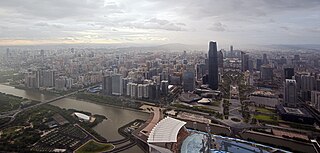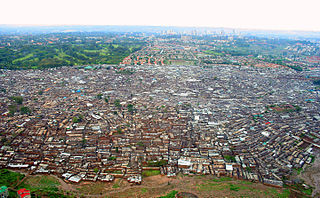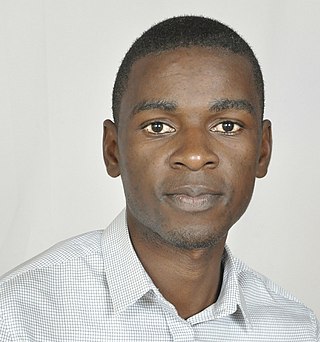Related Research Articles

A city is a human settlement of notable size. It can be defined as a permanent and densely settled place with administratively defined boundaries whose members work primarily on non-agricultural tasks. Cities generally have extensive systems for housing, transportation, sanitation, utilities, land use, production of goods, and communication. Their density facilitates interaction between people, government organisations and businesses, sometimes benefiting different parties in the process, such as improving efficiency of goods and service distribution.

Kinshasa, formerly Léopoldville, is the capital and largest city of the Democratic Republic of the Congo. Once a site of fishing and trading villages situated along the Congo River, Kinshasa is now one of the world's fastest growing megacities.

Urbanization refers to the population shift from rural to urban areas, the corresponding decrease in the proportion of people living in rural areas, and the ways in which societies adapt to this change. It is predominantly the process by which towns and cities are formed and become larger as more people begin living and working in central areas.

Dodoma, officially Dodoma City, is the national capital of Tanzania and the capital of the Dodoma Region, with a population of 410,956. In 1974, the Tanzanian government announced that the capital would be moved to Dodoma for social and economic reasons and to centralise the capital within the country. It became the official capital in 1996. Much of the initial design did not come to fruition for a long time. As a result, Dar es Salaam remains the commercial capital of Tanzania and still retains the state house Ikulu, and a large number of government functions.

A slum is a highly populated urban residential area consisting of densely packed housing units of weak build quality and often associated with poverty. The infrastructure in slums is often deteriorated or incomplete, and they are primarily inhabited by impoverished people. Although slums are usually located in urban areas, in some countries they can be located in suburban areas where housing quality is low and living conditions are poor. While slums differ in size and other characteristics, most lack reliable sanitation services, supply of clean water, reliable electricity, law enforcement, and other basic services. Slum residences vary from shanty houses to professionally built dwellings which, because of poor-quality construction or lack of basic maintenance, have deteriorated.

Nelson Mandela Bay Municipality is one of eight metropolitan municipalities in South Africa. It is located on the shores of Algoa Bay in the Eastern Cape Province and comprises the city of Port Elizabeth (Gqeberha), the nearby towns of Uitenhage and Despatch, and the surrounding rural area.

Kibera is a division of Nairobi Area, Kenya, and neighbourhood of the city of Nairobi, 6.6 kilometres (4.1 mi) from the city centre. Kibera is the largest slum in Nairobi, and the largest urban slum in Africa. The 2009 Kenya Population and Housing Census reports Kibera's population as 170,070, contrary to previous estimates of one or two million people. Other sources suggest the total Kibera population may be 500,000 to well over 1,000,000 depending on which slums are included in defining Kibera.
Slum/Shack Dwellers International (SDI), is a global social movement of the urban poor that started in 1996. It forms a network of community-based organisations in more than 30 countries across Africa, Asia, Latin America and the Caribbean.

Otto H. Königsberger was a German architect who worked mainly in urban development planning in Africa, Asia and Latin America, with the United Nations.
The following is a timeline of the history of the city of Abidjan, Ivory Coast.
The following is a timeline of the history of the city of Lusaka, Zambia.
Eugenie L. Birch is an American scholar and city planner specializing in international and domestic planning history and urban revitalization.
Arcot Ramachandran (1923-2018) was an Indian scientist, anthropologist, author and a former Under-Secretary General of United Nations Centre for Human Settlements, known for his scholarship on the subjects of heat and mass transfer and environment and his social commitment to the cause of sustainable development. The Government of India honoured him in 2003, with the Padma Bhushan, the third highest civilian award, for his services to the fields of Science and Engineering.

Cities Alliance is a global partnership fighting urban poverty and supporting cities to deliver sustainable development. To manage its activities, the Cities Alliance operates a multi-donor fund with UN Office for Project Services (UNOPS), as host and trustee. Different members provide direction, financing and advocacy. Cities Alliance aims to deliver solutions to urban poverty.
Habitat III, the United Nations Conference on Housing and Sustainable Urban Development, took place in Quito, Ecuador, from 17 – 20 October 2016.
LSE Cities is a research centre at the London School of Economics and Political Science.

Dato' Seri Paduka Maimunah binti Mohd Sharif is the Executive Director of the United Nations Human Settlements Programme (UN-Habitat). She assumed office in January 2018, becoming the first Asian woman to serve as Executive Director of UN-Habitat. On 20 January 2022, she was re-elected by the UN General Assembly for a two-year term that ends on 19 January 2024.

Climate change and cities are deeply connected. Cities are one of the greatest contributors and likely best opportunities for addressing climate change. Cities are also one of the most vulnerable parts of the human society to the effects of climate change, and likely one of the most important solutions for reducing the environmental impact of humans. More than half of the world's population is in cities, consuming a large portion of food and goods produced outside of cities. The increase of urban population growth is one of the main factors in air-quality problems. In the year 2016, 31 mega-cities reported having at least 10 million in their population, 8 of which surpassed 20 million people. The UN projects that 68% of the world population will live in urban areas by 2050. Hence, cities have a significant influence on construction and transportation—two of the key contributors to global warming emissions. Moreover, because of processes that create climate conflict and climate refugees, city areas are expected to grow during the next several decades, stressing infrastructure and concentrating more impoverished peoples in cities.

The African Planning Society (APS) is a professional association representing the field of urban planning in Africa. Its mission is to create African communities that are more prosperous, sustainable, and inclusive.

Archimedes Muzenda is the Secretary-General of the African Planning Society. Prior to his appointment as the secretary-general in January 2020, he previously served as the director of African Planning Society from January 2019. Archimedes Muzenda is the inaugural holder of the office after it was established following the merger of African Planning Association with African Urban Community of Practice (AUCoP) an initiative of African Urban Institute to form African Planning Society. His mandate as inaugural secretary-general was outlined at the conference of Association of African Planning Schools in Tanzania.
References
- ↑ "UN-Habitat and Association of African Planning Schools". UN Habitat . Archived from the original on 2021-04-11.
- ↑ "Moving On: The Journey of the Association of African Planning Schools (AAPS)". Cities Alliance. 2016. Archived from the original on 2022-01-10.
- ↑ Watson, Vanessa; Odendaal, Nancy (2013). "Changing Planning Education in Africa: The Role of the Association of African Planning Schools". Journal of Planning Education and Research . 33 (1): 96–107. doi:10.1177/0739456X12452308 – via Sage.
- ↑ Odendaal, Nancy (2012). "Reality check: Planning education in the African urban century". Cities. 29 (3): 174–182. doi:10.1016/j.cities.2011.10.001 – via Elsevier.